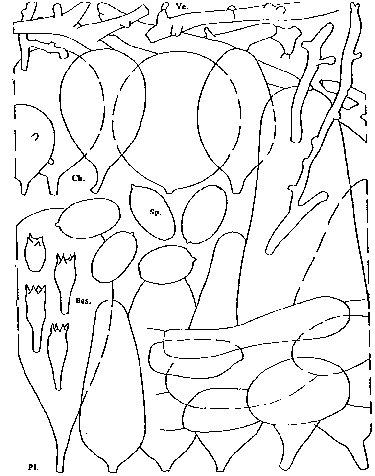Macroscopic features |
Pileus 8-18 x 6-16 mm when still closed, ellipsoid, ovoid or oblong, first sulphur to citrine yellow, darker and more yellow towards the centre, becoming more yellow at maturity then isabelline towards the margin; expanded pileus 8-22 mm, distinctly umbonate, fibrillose scurfy throughout or more velvety at the disk, striate then sulcate at margin. Lamellae crowded, free, first whitish, then grey, finally violaceous black, whitish floccose at margin when young. Stipe up to 60 x 1-1.5 mm, 2-3 mm at base, hyaline or slightly brownish, equal except for slightly bulbous base which is coated with sulphur or olivaceous hyphae. |
Microscopic features |
Spores [40,2,2] 9.6-11.8 x 5.3-6.8 µm, oblong, mainly rounded at apex, dark brown, with central, c. 1.6 µm wide germ pore; Q = 1.58-2.00, av. Q = 1.67-1.85; av. L = 10.3-10.9, av. B = 5.9-6.5 µm. Basidia 14-28 x 8-10 µm, 4-spored, surrounded by (3-)4-6 pseudoparaphyses. Pleurocystidia 75-175 x 25-50 µm, utriform, cylindrical or ellipsoid. Cheilocystidia 35-100 x 25-50 µm, globose to ellipsoid or broadly utriform. Elements of veil thin-walled, sometimes slightly thick-walled (< 0.5 µm) and yellowish, diverticulate, up to c. 100 x 2-10(-12) µm. Clamp-connections present. |
Habitat & distribution |
On horse dung, solitary or a few together. Very rare. Not known from the Netherlands. Only known to us by the two collections cited by Watling (l.c.) and the statement by Bender (1991: 11) from Germany. |
Remarks |
The macroscopical description is based on Watling (l.c.). Coprinus luteocephalus is microscopically close to C. xenobius (for differences, see the discussion under C. xenobius). In subsect. Alachuani the only other species with oblong spores is C. goudensis and that species grows on wood, the spores are distinctly smaller and the cystidia are ellipsoid or subcylindrical, never utriform. |

[Copyright © by ]